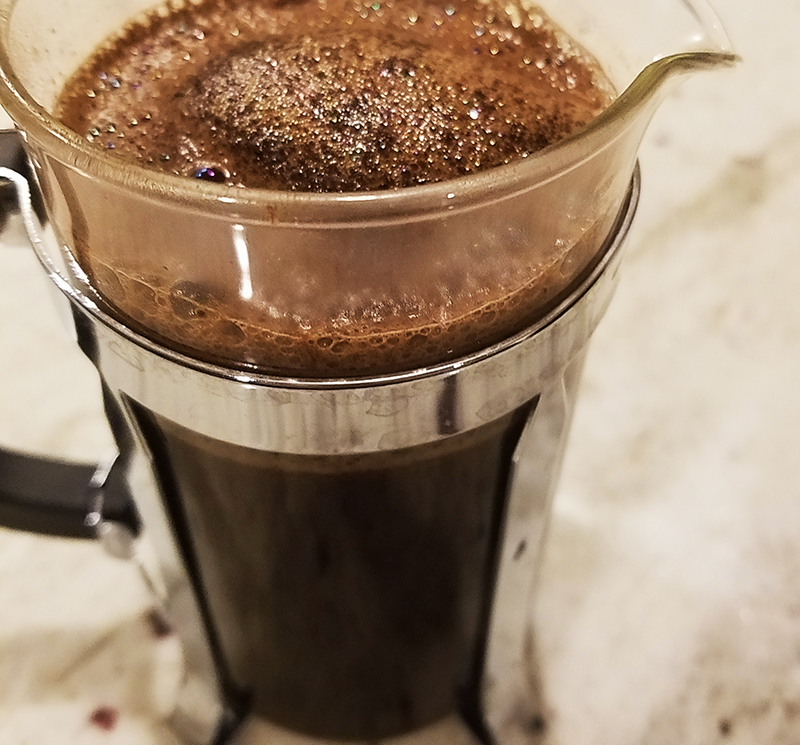A better cup of french press coffee

I’m a little obsessive about… some things… well, ok, maybe most things, and especially most things that are food-related. One of the things I’m probably most obsessive about is my coffee, which I roast at home from green beans, grind in one of three grinders I own (depending on the brewing process), weigh with a scale that is accurate to .01 gram, and brew with temperature-controlled water. After a couple decades of obsessing over every aspect of my coffee, I thought I knew coffee. That’s why it was a pleasant surprise to learn something new last year!
After trying every brewing method known to humankind (a subject for a future blog post, perhaps), I’ve settled on a few that are reliable favorites. One of those is the French press, which is a tool that many of my readers probably use too. It’s simple, fast, and reliable: you grind coffee, dump it in the pot, pour water over it, wait a few minutes, push the plunger, and you have coffee. Simple, right? If that’s how you’re doing it, you’re doing it like most people do, and you’re doing it wrong. A little thing can make a big difference.
To me, the beauty of a cup of French press coffee is its simplicity—it’s almost rustic. It has coffee oil floating on top, probably some grounds in the cup, and it’s sometimes almost a cup of coffee you feel you can chew! This is good, but there’s a simple way to clean up the cup that makes it sparkle.
See the picture on this page? That foam on top is a good thing; it’s a sign that your coffee is fresh roasted. Fresh roasted coffee outgases (primarily carbon dioxide) for a few days. If you roast coffee and seal it in a bag, the bag will puff up as the coffee gives off gas. (That’s why the packages of coffee you buy have that little valve in it; it’s not so you can squeeze air out.) If you have just-roasted coffee, grind it, and pour water over it, it will foam like you poured soda water over it.
That foam on top of the cup also holds some bean chaff and a lot of the oil in the coffee. If you remove the foam, you’ll completely change the way the cup tastes. Next time you try making a cup of French press, try this:
Clean your equipment if you have time. If there’s one thing most people can do to make a radical improvement in their coffee, it’s to use clean brewing equipment. With a lot of the plastic contraptions in peoples’ homes, it’s almost impossible to get them clean, but a French press is easy: just take it apart and run it through the dishwasher once a week. Commercial dishwashing detergents are very good at removing oils.
Grind your coffee, and put it in the press. Heat your water to boiling and then wait a few seconds for it to cool. Pour your just-off-boiling water over the coffee, but only fill the press about half way. Wait one minute or so.
Here’s what’s different: take your half-filled press, and stir the coffee and water together with a spoon after about a minute. If your coffee is fresh, you’ll find a lot of foam on the surface. Carefully spoon that foam off, and throw it in the sink. With this one step, you’re removing a lot of the oil and woody elements of the bean that give the coffee a dirty taste. While you’re doing this, re-boil your water.
Once you’ve stirred and spooned the foam off (which should only take 10-15 seconds), take the reboiled water and fill the press fully. This second hit of water is also good because it will maintain the brewing temperature better.
Let the coffee brew for your normal time, plunge it, and pour. See what you think!
I’m always excited when I find some little tweak that makes a worthwhile change in the results. I don’t know how many thousands of cups of French press coffee I’ve made over the years, but this was an eye-opening difference! Also… expect to see more food-related posts on my blog in coming months. ?



